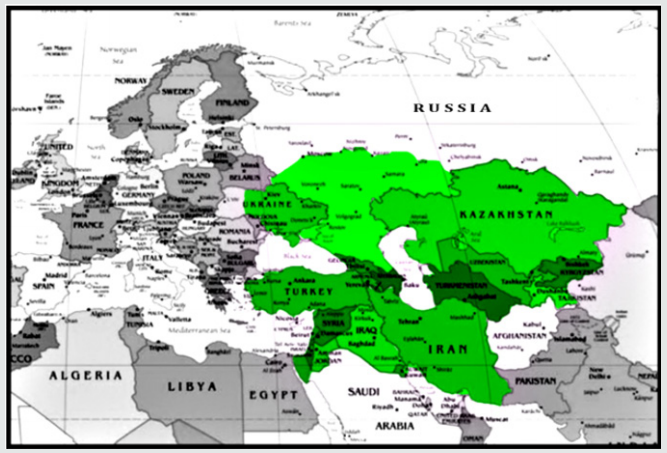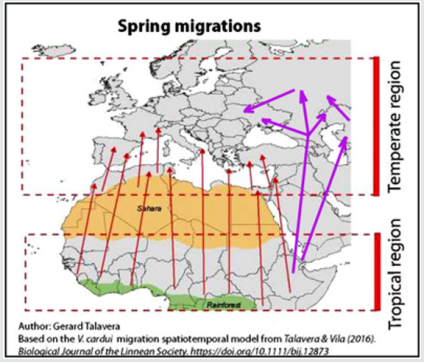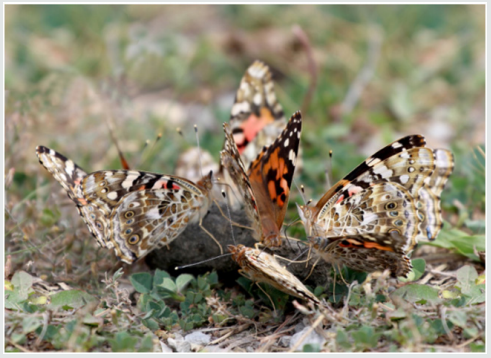
Lupine Publishers Group
Lupine Publishers
Menu
ISSN: 2637-4749
Research Article(ISSN: 2637-4749) 
About Mass Migration of Painted Lady Butterfly (Vanessa Cardui L.) To Eurasia in 2019 Volume 2 - Issue 5
Vitaly Dobronosov*
- National Park Alania, Vladikavkaz, Russia
Received: June 17, 2019; Published: June 25, 2019
Corresponding author: Vitaly Dobronosov, National Park Alania, Vladikavkaz, Russia
DOI: 10.32474/CDVS.2019.02.000149
Abstract
Research purpose was establishment of distribution’s width of painted lady butterfly across Eurasia because of mass migration of 2019. The publications in media, private messages of detached onlookers and standard techniques of visual observations and photo fixings on routes were used. For assessment of abundance of butterflies, the method of the quantitative account of Lepidoptera for the biogeographical purposes by visual accounting of quantity of the met specimens on a route per unit of time was used. This method, despite many critical remarks for high relativity (inaccuracy), allows gaining an impression about the number of specimens in the particular territory without mass catching and, respectively, extermination of butterflies. The digital camera was used to photo shots. Field observations were made during migration of butterflies from May 25 to June 06, 2019 in the neighborhood of the city and in the city of Vladikavkaz and in Daryalskoe, Zakkinskoe and Digorskoe gorges. The statistical analysis showed that for May and the first week of June the butterflies were widely extended, both in Asian, and in East European parts of Eurasia. The obtained data generally confirm the assumption that penetration of painted lady butterflies on the East European (Russian) plain during spring migrations happens partially through the Caucasus, Central Asia, bending around the Caspian Sea and the Black Sea, or over their water area.
Keywords: Painted Lady Butterfly; Vanessa Cardui L.; Field Observations; Mass Migrations; Eurasia; East European Plain; Caucasus; Central Asia
Introduction
The migration behavior meets at butterflies infrequently. About two tens from them make long on distance and regular flights. Erratic butterflies make flights as alone and uniting in packs. Species, making the regular migrations, usually legibly follow a particular route, which often coincides with the direction of migration paths of birds. Scientists began to be engaged in studying of migrations of butterflies in the middle of the 20th century. The method similar to that, which is applied when studying flights of birds was for this purpose used – insects are, marked special tags. To deal with flight of erratic insects, the team of the British scientists under the leadership of Jason W. Chapman for eight years scanned a palate two radars which are expressly designed for entomology located in the territory of Great Britain. High-precision radars scanned space in a vertical beam with a diameter of 32 meters. Were observed annually during the periods of mass migration of butterflies – in the spring and in the fall. Radars recorded objects at the height from 150 to 1188 m. It was established that a wind relocated erratic insects; they move in an airflow and use this transport exclusively efficiently. Though a wind not always is passing, they manage to get there where it is necessary, overcoming for a short time huge distance. Researchers tried to understand how insects manage to fly so quickly and as they choose the right direction. It was established that the speed of movement of insects exceeds the wind speed as they move in a stream actively, i.e. wave wings, adding these to the speed of wind from 3 to 6m/c. Long-term observations how butterflies manage to hold the correct course, and raise very many questions. It is apparent that the main direction of migrations – in the spring to the north, and in the fall to the south. Are cited data that in a filing point the actual movement of butterflies is differed from the direction of their own driving on some corner. That is, the head and a body of an insect were focused, we will tell the north, but because of wind, it moved at an angle to the North. In other words, butterflies are capable to make allowance for a wind and to actively adjust a course in the necessary direction, moving a traverse. How they actually do it, remains unclear. The model computer experiment, for the proof of influence of the fissile behavior of insects during flight on its effectiveness was made. The model of a dispersive dispelling of particles (NAME) and comparison of movement of shallow particles of the insects, comparable to the sizes, which are virtually let out in Great Britain with model movement of insects was used. Results showed that in eight clocks of the virtual flight insects promoted 40% further, than the particles, which are passively moved in a wind stream, and the direction of their flight it appeared much more precisely. Authors, certainly, used interesting approach to a research of migration of insects. For today, very few attempts of the experimental studying of this phenomenon are made [1].
From the European species, not many species are capable to the regular migrations. According to literature [2,3], painted lady butterflies’ winter in North Africa where they breed, and the new generation of butterflies migrates to the north where the summer generation is brought. At the end of summer, butterflies of this generation migrate back to Africa. In the spring, the cycle is repeated again. At migrations of painted lady butterflies fly groups, with a speed of 25-30km/h, and can overcome up to 500km a day. Total length of their flight according to some data [4] reaches 5000km, on others – 12000km [2,3]. The mass migrations of painted lady butterflies on the European North, which are taking place the wide front from the Urals to Scandinavia, were observed in 1996, 2009 and 2014. In 2019, such scale explained in the rainy winter after which everything became covered by greens around, creating ideal conditions for manifolding of butterflies. By estimates of members of the Israeli Association of butterfly’s fans, Israel visited from 700 million to one billion butterflies. In addition, it is one of the most scale migrations, which were observed in Israel in recent years.
According to B. Tuniyev [5] mass manifolding of butterflies in the Atlas Mountains and in the north of the Sahara became the reason for migration. They extended across Europe, Asia Minor, having flown over the Mediterranean Sea, and reached South Caucasus and Russia. Appearance of painted lady butterflies on East European Plain is studied less explicitly, than paths of migration in Central and Western Europe, but it is supposed that butterflies fly through Arabian Peninsula, and further-partially through the Caucasus, Central Asia, bending around the Caspian Sea and the Black Sea, or flying over their water area [6]. The purpose of the research was establishment of distribution width of painted lady butterflies across Eurasia because of mass migration in 2019.
Materials and Techniques
We used materials of media publications, private messages of detached onlookers and standard techniques of visual observations and photo fixings on routes [7]. For assessment of the number (abundance) of butterflies, we used a method of the quantitative account of butterflies for the biogeographical purposes. According to this technique, the number of species of butterflies was considered by visual accounting of the met specimen’s quantity on a route per unit of time. Species which for an hour were met in number of 100 specimen and more are considered as very numerous; from 10 to 99 specimen – numerous; from 1 to 9 specimen–routine; from 0.1 to 0.9 specimen – not numerous and rare, 0.09 specimen/hour – very infrequent. This method, despite many critical remarks for high relativity (inaccuracy), allows to gain an impression about the number of species in the particular territory without mass catching (and, respectively, destruction) butterflies [8]. The digital Sony DSC-H300 camera was used to photo shots. The study area and places of mass appearance of painted lady butterflies are shown in the schematic map (Figure 1).
Figure 1: The study area, green - places of mass appearance of painted lady butterflies (Vanessa cardui L.) in 2019.

Results and Discussion
Migration of painted lady butterflies in the current year reached the sizes unprecedented earlier. Monitoring data of media publications, messages of detached onlookers and results of our visual accounts demonstrate to it. According to internet mass media [9] in January 2019, the splash in number of painted lady butterflies was recorded in Israel and Turkey. Therefore, by estimates of the Israeli Association of butterfly’s fans members, Israel visited from 700 million to 1 billion butterflies (data on 22.03.2019). In addition, it is one of the most scale migrations, which were observed in Israel in recent years. According to the data published in internet of 18.04.2019 [10] mass congestions of painted lady butterflies were noted in Lebanon and in mountainous areas of Turkey.
The subsequent publications [11,12] and data of our visual observations, showed that for May and the first week of June 2019 butterflies are widely extended, both in Asian, and in East European parts of Eurasia. Summary data of publication’s monitoring and our visual observations present in the table (Table 1). Our visual observations across North Ossetia 30.05.2019 in Daryalskoe and its western branch Suargomskoe gorges recorded very high number of butterflies (Figure 2) which by the applied technique, was characterized by the concept “are very numerous”. Driving of this mass of butterflies in the northern direction was legibly traced. Telephone communication was at the same time received from the state inspector of National park “Alania” about the similar phenomenon occurring in the Digorskoe gorge near the village Lower Zadalesk; 31.05.2019 the oral message confirmed with video filming was received from the employee of the Ministry of Natural Resources and Environmental Protection RNO-Alania about grassroots movement of painted lady butterflies in the direction the South – the North in the Zakkinskoe gorge of the republic. Were at the same time observed as it is strong, and very poorly shabby individuals 01.06.2019 and 03.06.2019 on southern (The water station) and southeast (the foothills of the Lesistyj ridge) the vicinities of the city of Vladikavkaz and also on flower beds on avenues, in the yards, squares and parks of the city. Daryalskoe and Zakkinskoe gorges, upper courses of the Digorskoe gorge are on border with the Republic Georgia that confirms passing of migration through its territory [13-15].
Conclusion
The data obtained during realization of a research despite some incompleteness, generally confirm the assumption that penetration of cosmopolites on the East European (Russian) plain during spring migrations happens partially through the Caucasus, Central Asia, bending around the Caspian Sea and the Black Sea, or over their water area (Figure 3). The subject of seasonal mass migrations of painted lady butterflies remains still studied insufficiently and researches in this direction will be continued.
Figure 3: Number of lambs born per group (G1 and G2) in each birth and lambs born total by group (G1 and G2).

References
- Talavera G, Viala R (2017) Discovery of mass migration and breeding of the painted lady butterfly Vanessa cardui in the Sub-Sahara: the Europe - Africa migration revisited. Biological Journal of the Linnean Society 120: 274-285.
- Leah Rosenbaum (2018) Each year painted lady butterflies cross the Sahara - and then go back again. Science News. 194(2): 04.
- https://scientificrussia.ru/articles/repejnitsy-migriruyut-na-samye-bolshie-rasstoyaniya-sredi-vseh-babochek
- https://agrostory.com/info-centre/knowledge-lab/chertopolokhovka-ili-repeynitsa/
- http://news.rufox.ru/texts/2019/05/04/352258.htm
- https://oleniy.ru/novosti/167-massovaya-migratsiya-babochki-repejnitsy-vanessa-cardui-po-territorii-prirodnogo-parka-olenij
- Dunayev EA (1997) Methods of ecology-entomological researches. M.: Mosgorsyun, p. 44
- Kuzyakin AP, Mazin LN (1984) The quantitative accounts of Lepidoptera for the biogeographical purposes // The IX congress of All-Union entomological society: Tez. rep. Kiev Naukova dumka (Part 1): 268.
- https://cyprusbutterfly.com.cy/news/attention-millions-of-butterflies-in-the-skies-over-cyprus.
- https://www.thenational.ae/world/mena/butterfly-mass-migration-lingers-in-lebanon-through-wet-spring-1.850812.
- http://orken-media.kz/2019/05/22/v-balhashe-nebyvaloe-nashestvie-babochek/
- https://www.dialog.tj/news/nashestvie-babochek-v-tsentralnoj-azii-ob-yasnili-dozhdlivoj-vesnoj
- https://media.az/society/1067735850/stala-izvestna-prichina-nashestviya-babochek-v-baku-video/
- http://cominf.org/node/1166523026
- https://rosselhoscenter.com/index.php/otchjoty-160/16822-krymskie-agrarii-obespokoeny-nashestviem-babochek-repejnits

Top Editors
-

Mark E Smith
Bio chemistry
University of Texas Medical Branch, USA -

Lawrence A Presley
Department of Criminal Justice
Liberty University, USA -

Thomas W Miller
Department of Psychiatry
University of Kentucky, USA -

Gjumrakch Aliev
Department of Medicine
Gally International Biomedical Research & Consulting LLC, USA -

Christopher Bryant
Department of Urbanisation and Agricultural
Montreal university, USA -

Robert William Frare
Oral & Maxillofacial Pathology
New York University, USA -

Rudolph Modesto Navari
Gastroenterology and Hepatology
University of Alabama, UK -

Andrew Hague
Department of Medicine
Universities of Bradford, UK -

George Gregory Buttigieg
Maltese College of Obstetrics and Gynaecology, Europe -

Chen-Hsiung Yeh
Oncology
Circulogene Theranostics, England -
.png)
Emilio Bucio-Carrillo
Radiation Chemistry
National University of Mexico, USA -
.jpg)
Casey J Grenier
Analytical Chemistry
Wentworth Institute of Technology, USA -
Hany Atalah
Minimally Invasive Surgery
Mercer University school of Medicine, USA -

Abu-Hussein Muhamad
Pediatric Dentistry
University of Athens , Greece

The annual scholar awards from Lupine Publishers honor a selected number Read More...






